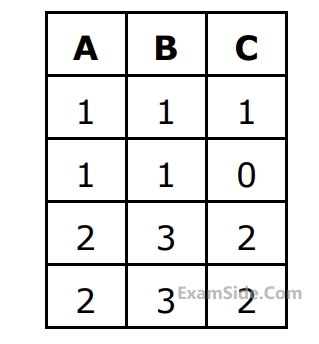1
GATE CSE 2004
MCQ (Single Correct Answer)
+2
-0.6
The relation scheme student Performance (Name, CourseNo, RollNo, Grade) has the following functional dependencies:
Name, courseNo $$\,\, \to \,\,$$ grade
RollNo, courseNo $$\,\, \to \,\,$$ grade
$$\,\,\,\,\,\,\,\,\,\,\,\,\,\,\,$$$$\,\,\,\,\,\,\,\,\,$$ Name $$\,\, \to \,\,$$ rollNo
$$\,\,\,\,\,\,\,\,\,\,\,\,\,$$$$\,\,\,\,\,\,\,\,\,$$ RollNo $$\,\, \to \,\,$$ name
The highest normal form of this relation scheme is
2
GATE CSE 2004
MCQ (Single Correct Answer)
+2
-0.6
A relation Empdt $$1$$ is defined with attributes empcode (unique), name, street, city, state and pincode. For any pincode, there is only one city and state. Also, for any given street city and the state, there is just one pincode. In normalization terms, Empdt$$1$$ is a relation in
3
GATE CSE 2003
MCQ (Single Correct Answer)
+2
-0.6
Consider the following functional dependencies in a database.
$$\eqalign{ & \,\,\,\,Date\,\,of\,\,Birth\,\, \to \,\,Age \cr & \,\,\,\,\,\,\,\,\,\,\,\,\,\,\,\,\,\,\,\,\,\,\,\,\,\,Age\,\, \to \,\,Eligibility \cr & \,\,\,\,\,\,\,\,\,\,\,\,\,\,\,\,\,\,\,\,\,\,Name\,\, \to \,\,Roll\_number \cr & \,\,\,\,\,Roll\_number\,\, \to \,\,Name \cr & Course\_number\, \to \,\,Course\_name \cr & Course\_number\, \to Instructor \cr & (Roll\_Number,\,Course\_number)\,\, \to \,\,Grade \cr} $$
$$\eqalign{ & \,\,\,\,Date\,\,of\,\,Birth\,\, \to \,\,Age \cr & \,\,\,\,\,\,\,\,\,\,\,\,\,\,\,\,\,\,\,\,\,\,\,\,\,\,Age\,\, \to \,\,Eligibility \cr & \,\,\,\,\,\,\,\,\,\,\,\,\,\,\,\,\,\,\,\,\,\,Name\,\, \to \,\,Roll\_number \cr & \,\,\,\,\,Roll\_number\,\, \to \,\,Name \cr & Course\_number\, \to \,\,Course\_name \cr & Course\_number\, \to Instructor \cr & (Roll\_Number,\,Course\_number)\,\, \to \,\,Grade \cr} $$
The relation (Roll_number, Name, Date_of_Birth, Age) is
4
GATE CSE 2002
MCQ (Single Correct Answer)
+2
-0.6
From the following instance of a relation schema $$R(A, B, C),$$ we can conclude that:


Questions Asked from Marks 2
GATE CSE 2025 Set 2 (1) GATE CSE 2025 Set 1 (1) GATE CSE 2024 Set 2 (1) GATE CSE 2024 Set 1 (1) GATE CSE 2021 Set 2 (1) GATE CSE 2021 Set 1 (1) GATE CSE 2020 (1) GATE CSE 2019 (1) GATE CSE 2015 Set 1 (1) GATE CSE 2014 Set 1 (1) GATE CSE 2013 (2) GATE CSE 2008 (3) GATE CSE 2007 (1) GATE CSE 2006 (2) GATE CSE 2005 (2) GATE CSE 2004 (2) GATE CSE 2003 (1) GATE CSE 2002 (2) GATE CSE 2001 (1) GATE CSE 2000 (1) GATE CSE 1999 (1) GATE CSE 1998 (2) GATE CSE 1997 (2) GATE CSE 1995 (1)
GATE CSE Subjects
Theory of Computation
Operating Systems
Algorithms
Digital Logic
Database Management System
Data Structures
Computer Networks
Software Engineering
Compiler Design
Web Technologies
General Aptitude
Discrete Mathematics
Programming Languages
Computer Organization